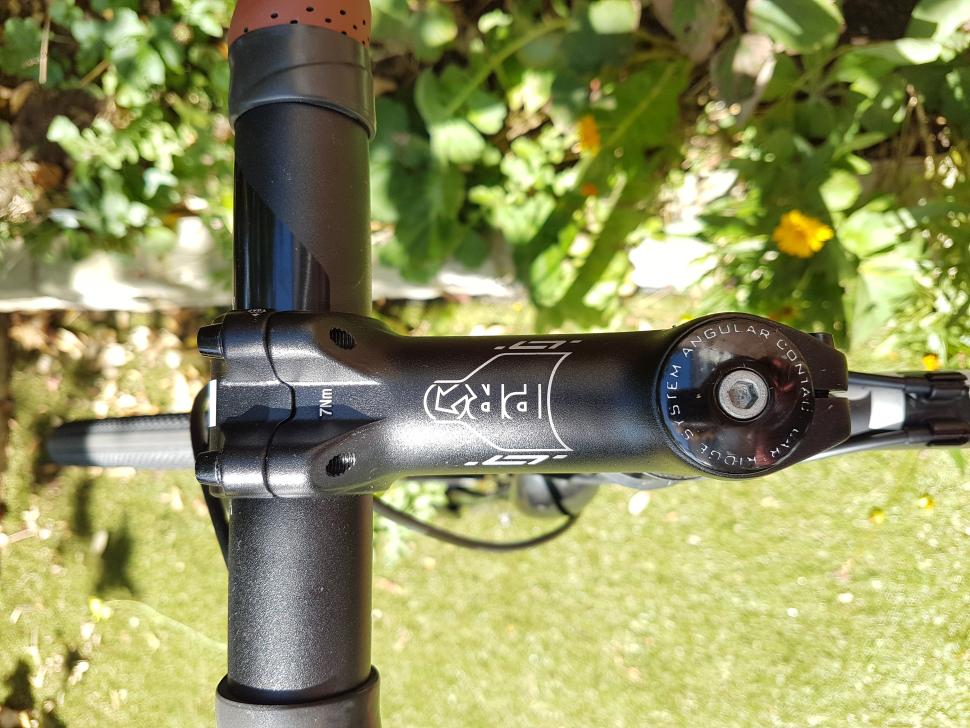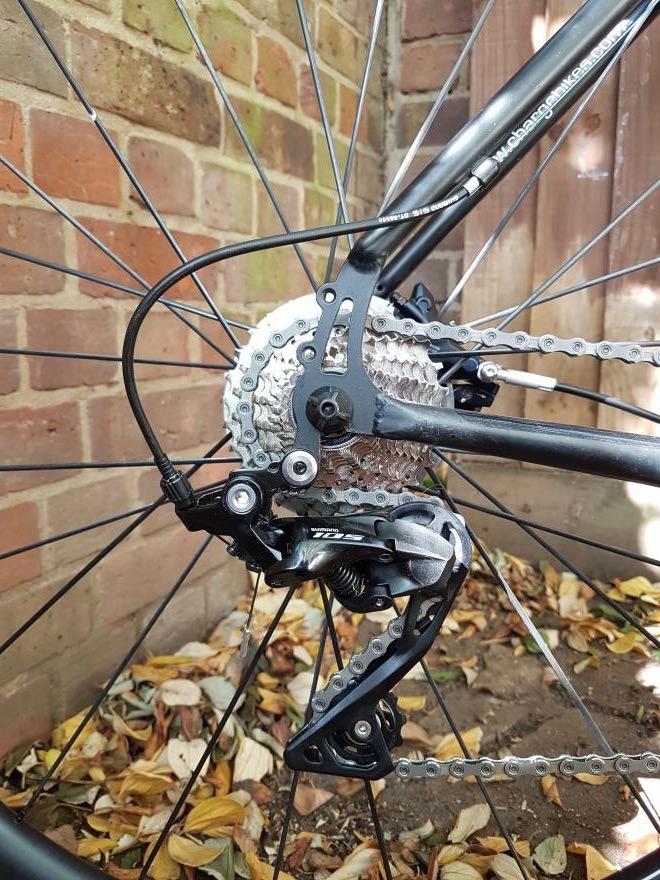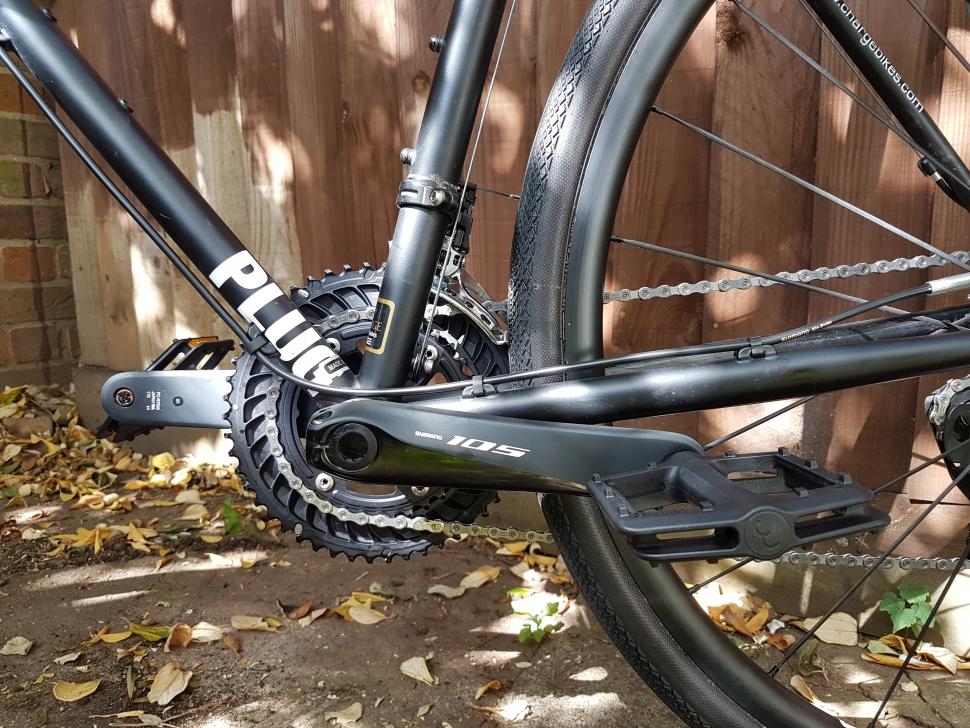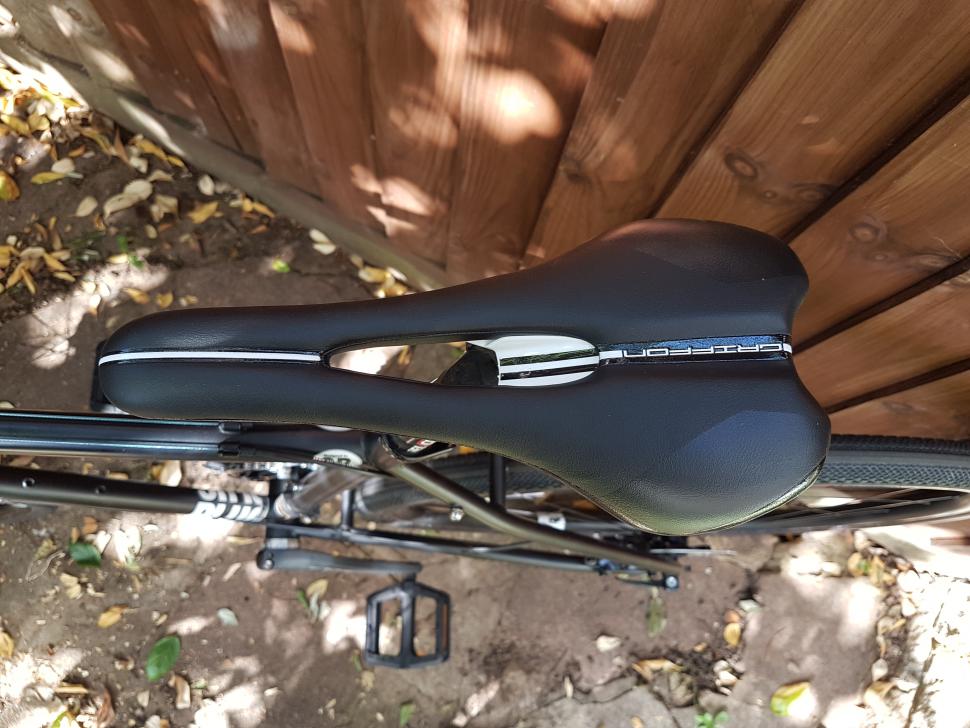- News
- Reviews
- Bikes
- Accessories
- Accessories - misc
- Computer mounts
- Bags
- Bar ends
- Bike bags & cases
- Bottle cages
- Bottles
- Cameras
- Car racks
- Child seats
- Computers
- Glasses
- GPS units
- Helmets
- Lights - front
- Lights - rear
- Lights - sets
- Locks
- Mirrors
- Mudguards
- Racks
- Pumps & CO2 inflators
- Puncture kits
- Reflectives
- Smart watches
- Stands and racks
- Trailers
- Clothing
- Components
- Bar tape & grips
- Bottom brackets
- Brake & gear cables
- Brake & STI levers
- Brake pads & spares
- Brakes
- Cassettes & freewheels
- Chains
- Chainsets & chainrings
- Derailleurs - front
- Derailleurs - rear
- Forks
- Gear levers & shifters
- Groupsets
- Handlebars & extensions
- Headsets
- Hubs
- Inner tubes
- Pedals
- Quick releases & skewers
- Saddles
- Seatposts
- Stems
- Wheels
- Tyres
- Health, fitness and nutrition
- Tools and workshop
- Miscellaneous
- Tubeless valves
- Buyers Guides
- Features
- Forum
- Recommends
- Podcast
OPINION
Laura builds an adventure bike!
I was somewhere in the North Downs, pedalling an entirely functional but totally inappropriate hybrid bike laden with panniers, amid undergrowth that appeared to be magically growing out of soft sand.
For my part, I was sinking. My too-skinny road tyres, the weight of the bike, and the presence of the panniers, was frankly hindering my progress significantly and I watched, as if in a dream, as my companions pedalled breezily ahead while I pushed the pedals in vain, skidding and sliding into the sand, and falling behind in slo-mo.
To be honest, the bike in question had taken a lot more in its life than was reasonable to expect of such a machine. A humble hybrid, the volume of aluminium that comprises its frame makes it both indestructible and rather too stiff – ie uncomfortable – over long distances.
Check out our latest gravel and adventure bike reviews
I’ve owned said bike for a decade, and in that time it’s taken me across Scotland, around the Netherlands, along the coast of Portugal, on paths made of rock, hard sand, soft sand, and even on a Portuguese motorway hard shoulder, in all weathers. It’s been lashed to a boat on the sea, crossed Dartmoor in freezing rain, carried me and my tent to festivals – all on top of its day job of London transportation.
There was no escaping the fact that the time for a new bike was long overdue.
Build it, and adventures will come
I was after an adventure bike that could handle bike packing and possibly touring, with some rough stuff thrown in, ideally made from steel because I've always wanted a steel bike, and not weighing too much. Something that could take me away from the hell of British roads, into the wild. Something on which I could get covered in mud, unfurl a small tent, sleep, get up and repeat.
I scoured the internet for new and secondhand steel-framed bikes and realised they can be expensive and hard to find in the right size.
As it happened, Tony Farrelly, co-founding father of road.cc, had a steel Charge Plug frame in my size kicking around the office, and he offered it to me for free to build up, for the purposes of journalistic research.
I cycled from Newbury to Bath to pick it up, the shooting pains in my hands along the rough Kennet and Avon Canal towpath underlining how ill-suited the heavy metal hybrid was for such things. I loaded the new frame on its pannier rack, and wheeled it, via the train, home to East London.
How to choose parts
The great thing and the scary thing about starting with a frame is you can choose what to put on it. First question was, what shape of handlebar did I want?
I toyed with the idea of flat bars; my hands are small and drops can be hard for braking and balance on off-road descents, as well as making my back ache. That said, Shimano now offers 105 gear shifters for smaller hands. I was nervous about the sharp pains my hybrid bike’s flat bars gave me, and I liked the different hand positions available with road bars. So, curly bars it was.
Handily for sizing, I’d recently had a professional road bike fitting at the Boardman Performance Centre. The new frame was the same size as my fitted road bike, so choosing handlebar width (36cm) and stem length was easy – I’d pick the same size. This Pro LT stem got good reviews on road.cc and wasn’t too pricey. Tick.
Gears, gears, gears
For gearing, I took to the internet. This feature explains the basics of gearing – with a focus on road, of course. The gearing on my road bike just isn’t low enough on hills for me, let alone gravelly climbs, so I wanted something lower.
road.cc’s John Stevenson points out that gearing on out-of-the-box gravel bikes often isn’t low enough for actual off-roading. As a solution he mixes road and mountain bike groupsets for a Franken-bike super-low gravel gearing – which Shimano advises strongly against as they aren’t designed for that. But Stevenson made it work.
Madison, the distributor that kindly provided many of the parts, said Shimano wouldn’t countenance such an approach, and mountain bike gearing won’t work with road bars and brakes, so road gearing it was: 52/36 chainrings rather than a 50/34 compact setup, and then somehow I ended up with not the lowest 11-speed cassette, an 11-28. The 36 x 28 isn't especially low but it's still lower than on my four-year-old road bike.
What do Cav and I have in common?
It’s a curious though perhaps predictable feature of cycling that gearing ratios are largely dictated by the pro peloton, and vary according to racing fashions.
As Ben from On Your Bike at London Bridge (the bike shop that did the build for me) put it: “The pros spin more these days, because they’re doing more and steeper climbs; which makes for better telly.”
Customers are sometimes baffled by this, though. He says: “People come in and say, ‘can you give me a higher gear, I’m spinning out’, and we say, ‘you’re really not, you’re just used to higher gearing, where you’re pushing a lower cadence’.
“This trend is good for us [regular riders] because it gives us more gearing options, and it’s actually better for the longevity of the gears, because you aren’t putting so much pressure on them.”
Though lower gearing has trickled down to the mass market, gears are still skewed above what a below average rider like me needs for rough stuff adventures. As John Stevenson puts it, “most of us aren’t Mark Cavendish sprinting down the Champs Elysees.”
A change is gonna come
Another little quirk of cycling is how quickly mounts and fittings change. I learned this when the bike shop called to say the disc brakes I’d selected didn’t fit with the frame mounts.
“I must have a weird frame,” I said.
“The thing is, you don’t,” said Ben. “It’s just that parts from five years ago aren't always compatible with today’s bikes.”
Thankfully there is a converter. On top of that, the frame’s front derailleur cable routing is along the top tube and down the seat tube, whereas my front derailleur requires the cable to come in from below, so another adaptor was needed.
Wiggle offers a useful guide to buying derailleurs here. You choose the length of rear derailleur cage based on the capacity you need (the difference in the number of teeth between the large and small chainrings added to the difference in the number of teeth between the largest and smallest sprockets) and the size of the largest sprocket.
My medium cage rear derailleur has a total capacity of 39T. This means that with my 52/36 chainset, I could swap my 11-28 cassette for an 11-34 in the future (although I'd need a longer chain) .
Wheels-wise, DT Swiss G1800 Spline 25 (G denoting gravel) is a decent, affordable option, and looks pretty cool with its loud white graphics. I went for my first tubeless setup to help avoid punctures. Tick.
Are you sitting comfortably?
The tyres are some good-looking Hutchinson Overides – their slightly brown sidewalls pleasingly match the brown bar tape I chose, which is the main thing! I opted for 35s in an attempt to get the balance between fatness – ie sand riding capability – and weight.
I naively thought saddles would be easy. I’d had my sit bones' width measured, and chose a saddle based on that width, with the cut out that tends to work for me – but not trying it out was a bad idea, as we’ll see.
Did I get what I wanted? What would I do differently?
The internet can be a double-edged sword and on the whole, I learned, its wealth of information can’t beat the personalised, expert advice you can get from, well, experts. In the case of someone unfamiliar with the vast options available when building bikes, those experts are skilled bike shop staff who know the pros and cons of different options, and how they fit with your individual situation and what you're after.
As On Your Bike’s Ben put it to me, as my bike levitated in the workshop repair stand: “We know you can buy parts online for less than we can buy them wholesale, but the reason we charge more is because we know what we’re doing.
“If you don’t know what you’re doing, tell us, and if we get enough lead-in time, we can help you choose those parts.”
We haven't had enough of experts
If I did it again I’d take Ben’s advice, talk it through with the shop, and perhaps be brave enough to go for mountain bike gearing, and possibly even flat bars, arguably more comfortable for me over longer rides. After agonising over flat or road bars for so long, without really talking it through with anyone, I perhaps funnelled myself needlessly into a road setup, gears and all, when it maybe isn’t the best option for me.
If I were to advise my two months' younger self I'd recommend not buying a saddle online unless you’re replacing one that you already know works. As soon as I sat on said saddle, I was conscious my whole weight would be on the soft tissue I didn’t want it to be on. My sit bones were entirely off the edges of the saddle.
I went to Hub Velo, an excellent independent bike shop in Hackney, whose knowledgable staff measured my sit bones again via a gel pad, getting a different figure from the first place. They also measure a rider’s lower back flexibility and, via a computer programme, suggest a number of saddles which they’ll fit for you.
I bought the saddle they suggested, rode it once and then set off on a 980-mile end-to-end ride on it (which you can read about here), and was very comfortable, thankfully. Don't try this at home.
I’ve no regrets over the build. I love my new bike; it looks great and I can’t wait to take it on some proper adventures. Over time I can tweak parts, but I think the theme here is, if you're new to this sort of thing, talk to the experts – it may be more expensive but you’re more likely to get the bike you want.
Laura Laker is a freelance journalist with more than a decade’s experience covering cycling, walking and wheeling (and other means of transport). Beginning her career with road.cc, Laura has also written for national and specialist titles of all stripes. One part of the popular Streets Ahead podcast, she sometimes appears as a talking head on TV and radio, and in real life at conferences and festivals. She is also the author of Potholes and Pavements: a Bumpy Ride on Britain’s National Cycle Network.
More Opinion
Latest Comments
- Rome73 2 sec ago
'Discovery Sports Europe’s president Andrew Georgiou said: “Combining the capabilities, portfolios, and scale of BT Sport and Eurosport UK will be...
- AidanR 7 min 21 sec ago
One thing we know for sure is that the car wasn't at fault, because it's just a machine. I think you mean the driver. ...
- Rome73 13 min 31 sec ago
What about using a VPN? I suppose you would still need a subscription to Eurosport in, say, France. Or find out where it is free to air and bingo....
- Wingguy 23 min 22 sec ago
No. You pretty much never have a tailwind (relative to the rider) unless you're on a very steep climb on a very windy day. There would be no point...
- Jaijai 41 min 49 sec ago
It really shows the incompetence of these governing body's. 7 months to decide that .
- ROOTminus1 5 hours 30 min ago
I can see why you drew that conclusion from my comment, but I assure you I have no sense of blaming the victims at Hillsborough....
- stonojnr 7 hours 50 min ago
"Chaotic road needs speed limit trial - police boss says" https://www.bbc.co.uk/news/articles/c4gz3n8175mo...
- bensynnock 9 hours 43 min ago
Some models have a front section that you can remove and rotate to permit the dipped beam while mounted upside down.
- David9694 10 hours 1 min ago
OK, OK, you get a £10 voucher to spend at the Diddly Squat farm shop.





















Add new comment
11 comments
You cycled home with the new frame tied onto your pannier rack? Tres impressed.
"I cycled from Newbury to Bath to pick it up, the shooting pains in my hands along the rough Kennet and Avon Canal towpath underlining how ill-suited the heavy metal hybrid was for such things. I loaded the new frame on its pannier rack, and wheeled it, via the train, home to East London."
OK yes, I could have read it in more detail instead of reading, seeing a picture, and skipping ahead to the comments. Maybe then I would have felt less stupid...
Iso disc mounts, so looks like you've had to buy an adaptor to post mount, and also new slx calipers because of the road ones are only available as flat mount. I really hope standards stay still for a while, there had been to much messing around the last few years.
You've made a great looking bike out of a free frame. Interesting to read the issues with fitting the brakes to a frame that is only a few years old. Cassettes and chainrings/chainsets are, as you know, easy to change if you find you need to - so not sure we need quite so many posts saying you have got it wrong. My last two bikes I've bought complete, and it was good to ride them quite a lot before deciding to chain the gearing slightly.
Have fun
Must agree with several posts above. I had to look twice at '52-36' for the chainset. Given Laura's stated need for easier gears, I can't see that she's acheived her aim. 46-30 is perfect for gravel and not too heavily laden touring. Pfaff's right about the FSA, or alternatively the Miche Graff that will slide straight into a Shimano bottom bracket.
As for not mixing road and mountain, my 10 speed 105 shifters and 9 speed XT derailleur work perfectly together, shifting between an FSA 46-30 chainset and SRAM 11-36 cassette. ( I expect this happy pairing is probably no longer an option with 11 speed systems. Can you still do the same with 11sp. road shifters and 10 speed mountain derailleurs?)
Hope you enjoy the bike Laura, it looks lovely, but I see a little tinkering on the horizon.
Congratulations and have fun! That's the important part and at the end of the day the only thing that matters, more than all the tech stuff. True, you made some choices that look a bit odd (and you can't simply slap flat bars on that frame, won't work) but perfect or not, you already outrode plenty of guys with 10k bikes set up just so who probably don't do 10% of the mileage that you do.
My cross/adventure/gravel/whatever bike has 46/36*11-32 ten speed. It's fine for road use, but if I'm off road with wide tyres 36*32 sometimes isn't low enough.
A FSA super compact crankset like 46/30 of any model will do the job perfectly as will a standard SRaM cassette 11-36, like the 1130
Used as a ”double single” setup this will provide fine gearings for loaded cykling at both flatlands and mountains.
I have substantially lower gearing on my road bike. The thought of a gravel bike with 52/36 and a 28-tooth cassette gives me the heebyjeebies.
I would've gone to a bike with thru-axles, I get that the frame was free , but I guess it was for a reason. Changing wheels is alot easier with thru-axles because the disc-rotor are always in the same place! Also I don't get why u went with a 52/36 11-28, a 50-34 11-34 is alot more usefull for a gravelbike, was that free to?
Honestly I think u made a few weird choices, some that are so weird that I think u didn't do any research before u bought it, u don't need a experts, just take a look at the spec from most of the gravelbikes and copy those!
Or get a cheap gravelbike like a Ribble CGR AL, Triban RC520 Gravel,...
Edit:
"those experts are skilled bike shop staff who know the pros and cons of different options, and how they fit with your individual situation and what you're after"
While I wish this was true it isn't my experience, some of the bikeshops I visited didn't even know what a gravelbike was and the once that knew it recommened bikes that were way to expensive and if they had a bike at the price I was searching for it would have parts that were 1 or 2 levels lower as bikes u can buy online (like Sora/tiagra instead of 105).